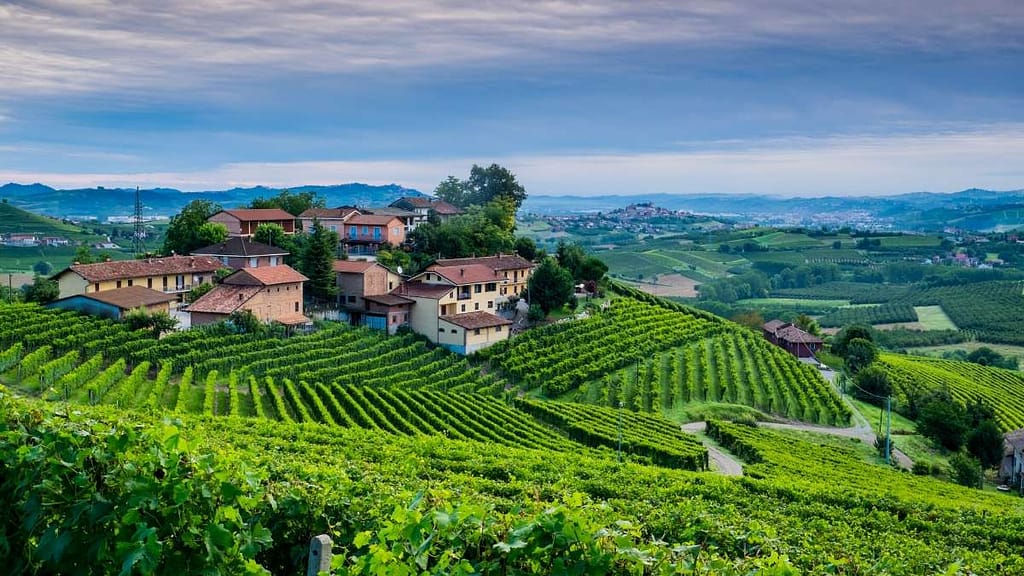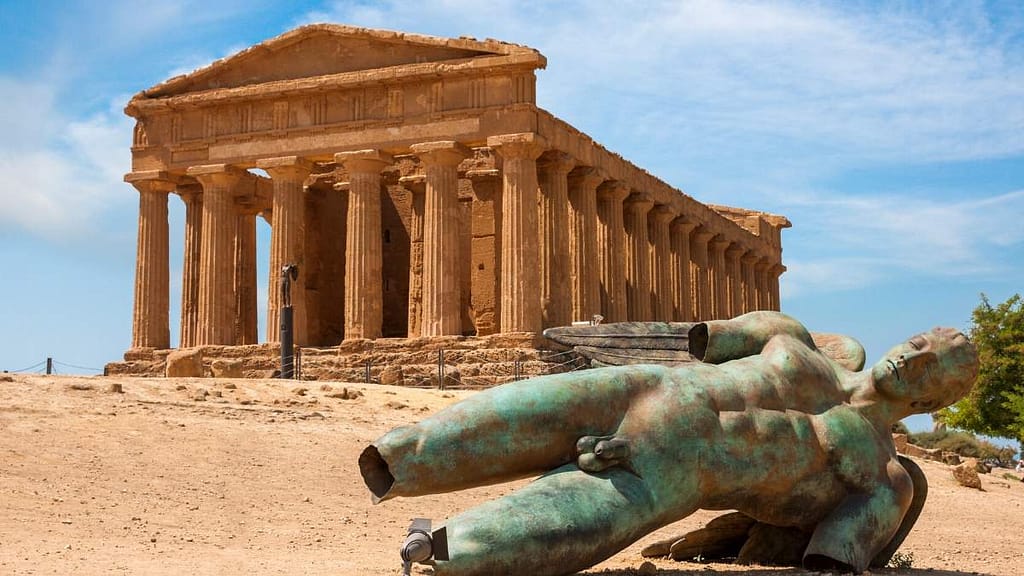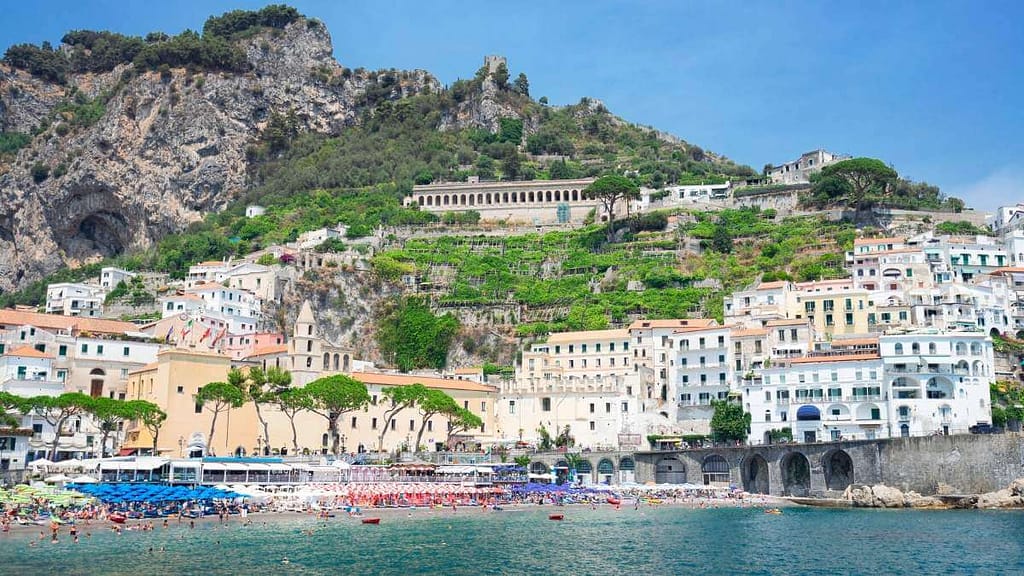There is no denying that Italian cuisine is one of the most popular in the world. With a focus on simplicity and flavour, Italian dishes are the go-to favourites for many. In Italy, food is always on the mind, and Italians constantly talk about food, making and eating it. We can’t say we blame them.
But, as you savour a slice of pizza or twirl spaghetti around your fork, have you ever wondered about the origins of these heavenly culinary delights? In this post, we’ll trace the journey of Italian food from its ancient beginnings to the sumptuous dishes that grace our tables today.
This post may contain compensated links. Find out more info in our DISCLAIMER.
Italian Food: A Mediterranean Love Affair
Before we even dive into Italian food history, let’s examine what makes it such a standout. Sure, other cultures have mouth-watering dishes and flavours, yet Italian takes the top spot (although sometimes it alternates with Japanese for the top spot). So, what gives?

Italian cuisine is a quintessential example of the Mediterranean diet, focusing on simple, natural ingredients prepared with minimal processing. The Mediterranean diet is associated with the cuisine of countries in this region, mainly Spain, France, Italy and Greece, emphasizing whole grains, fruit and vegetables, healthy fats, legumes and fish.


The Mediterranean diet is applauded for its health benefits, promoting heart health and potentially increasing life expectancy. Refined sugars and flours, processed foods, and red meat are consumed much less frequently in this diet, making it both sustainable and beneficial. So by this math, pasta in Italy is not just delicious, it’s good for you.
Influence and Popularity of Italian Cuisine
Today, we can see the influence of Italian food on global dining habits and tastes. The fusion of Italian and local cuisine has resulted in a culinary fusion of diverse dishes. For example, the United States has witnessed the birth of Italian-American dishes like spaghetti and meatballs or deep-dish pizza, now staples in the American food scene that are not the norm in Italy.
We get into a more in-depth conversation about food and discuss some of our fave dishes on our podcast Amongs Romans Pod. Check it out!
Fun facts about Italian food you might not know about:
- Pizza Margherita: Legend says that this classic pizza, made with tomato sauce, mozzarella, and basil, was created in 1889 to honour Queen Margherita of Savoy, using ingredients that represent the colours of the Italian flag.
- Coffee Etiquette: In Italy, it’s customary to down an espresso while standing at the bar. Also, drinking a cappuccino after 11 am is frowned upon.
- Parmesan Perfection: Authentic Parmesan cheese, or Parmigiano-Reggiano, is aged for a minimum of 12 months, and some varieties can be aged for up to 36 months, resulting in a rich and nutty flavour.


- Prosecco Origins: Prosecco, the sparkling wine enjoyed worldwide, is named after the village of Prosecco in the Veneto region of Italy, where it originated.
- Pasta Shapes and Meanings: Different pasta shapes serve specific purposes in Italian cuisine. For example, Orecchiette means “little ears,” as their concave shape is perfect for holding sauces.
- Tiramisu’s Sweet History: Tiramisu, a beloved Italian dessert, means “pick me up” in Italian, possibly referring to its coffee content or the mood-lifting effects of its deliciousness.


- Ferrero Rocher’s: The famous Ferrero Rocher chocolates, known for their hazelnut filling, were created in 1982 in Albo, Italy.
- Pasta Diversity: With over 600 different pasta shapes, Italians have pasta for every occasion and recipe, each designed to complement specific sauces and ingredients.
Food words in Italian commonly used internationally
Certain food words in Italian have become part of the vernacular in many other languages. Terms like “espresso” and “cappuccino” have entered daily life far beyond the cafes of Italy, appealing to coffee enthusiasts everywhere. Pizza and gelato have also become widely loved outside of Italy and have made their way to menus across the world.

Pasta varieties such as “spaghetti,” “fettuccine,” and “penne” are now standard terms in international cuisine. And did you know terms like “al dente” and “antipasto” stem from the Italian language? We unknowingly use these words globally, underscoring Italian food’s far-reaching influence.
Italian Food History: Ancient Origins
Long before the Roman Empire’s grandeur, the Etruscans and Greeks laid the foundations of Italian cuisine. They introduced staple ingredients such as grapes and olives and refined cooking techniques. With the Romans, grand feasts became symbols of power and prosperity, and they played a massive role in spreading Italian culinary practices across their empire.
The Romans (at least the wealthy ones) enjoyed lavish feasts that included elaborate dishes and copious amounts of wine. They hosted over-the-top banquets and experimented with different dishes and flavours that often required detailed preparation and complex ingredients.
@amongstromans There is no denying that food in Italy is on another level ???? #CapCut #italianfood #fyp #pasta #foodie #foodtiktok #foodlover #mangia #mangiarebene #wheninitaly #fyp #TravelItaly #discoveritalywithme #livinginitaly #ItalyAdventures
? La foule – Remastered – Édith Piaf
The Roman culinary style was a fusion of different flavours, often brought from conquered lands. Middle Eastern spices, grains from Northern Africa, fish from the Mediterranean and all kinds of meats dominated Roman tables. With the ample availability of wine, olive oil and grain became staples of the Roman diet. The fertility of the soil also provided a healthy mix of vegetables, cheeses and legumes.

As the Roman Empire neared its end, invading northern Barbarian tribes introduced their flavours. Butter and beer entered the culinary spectrum, mainly in the north, which led to new flavours and ingredients entering what eventually became known as northern Italian cuisine.
History of Italian Food in Medieval Times
The rise of Christianity had a profound influence on acceptable behaviour and food consumption. As the church imposed strict rules on its subjects, meat became associated with sin and immorality. Gone were the lavish banquets of the past and all related excesses. Abstinence and fasting, especially among the clergy, became the norm.
While the rest of the peninsula bowed under the Catholic Church’s rule, things were different in Sicily. The Middle Ages saw an influx of Arab and Byzantine influences, with exotic spices and methods weaving into Italian cooking. This era also witnessed the budding of local specialties, setting the scene for the rise of regional flavours that characterize Italian cuisine today.

Exotic spices, dried fruit and dried pasta entered the Sicilian diet. While the Arabic rulers brought pasta with them because of its convenience, the Italians made an art of it. Pasta spread throughout the land and into Europe.
Renaissance and Age of Exploration: A Culinary Revolution
Over time, religious austerity gave way to more moderate celebrations that combined fasting and excess. As the city-states became prosperous and wealthy, food became a symbol of wealth again. Traditions of the past were rediscovered in culinary preparation and consumption.
As explorers traversed the globe, new ingredients like tomatoes and corn arrived in Italy, dramatically altering the food landscape. This period also saw the birth of opulent banquet culture, brimming with inventive dishes that reflected Italy’s growing wealth and creativity. Even the papal court didn’t shy away from extravagant shows of culinary and entertainment displays.

Sugar was a symbol of wealth, and Venice led the way. As the major port for commerce, Venice was a wealthy and influential state with sugar control. Access to oriental spices also played a role in localized flavours. With the introduction of new foods from the colonies, Italian cuisine took some time to embrace them. Potatoes, corn, beans and even turkeys graced the tables and appetites of Italians of the time.
While lemons, oranges, sugar cane and almonds became part of southern cooking, more experimentation was happening in the north. Newly wealthy classes saw food as a status symbol and demanded new creations and refinement.
In the 16th century, tomatoes entered the scene, forever changing what we know as Italian cuisine. Potatoes, cabbage, sugar beets and peppers became the new staples, along with meat and fish. Tuscan hills became the source of wine and olive oil, infiltrating the kitchens of the time.

The Modern Age of Italian Cuisine
The quintessential combination of pasta and tomato sauce didn’t catch on until about the 17th century. Various trial and error experiments also produced tiramisu and pizza, dishes we consider to be traditional foods in Italy. Italians, much like the Romans before them, were quite skilled at adapting other foods and ingredients to their own cuisine.




During both World Wars, food scarcity forced cooks to work with what little was available. Once again, Italian cuisine had to adapt from lavish and elaborate to simple and creative. What became a hallmark of simple, peasant cooking is now a standard of what we know as Italian food.

Evolution of regional specialties
Nowadays, regional dishes like Neapolitan pizza, Tuscan steak, and Sicilian eggplant have achieved global fame. Specialty items such as Parmigiano-Reggiano and Prosciutto di Parma exemplify local specialization. From iconic Italian breakfast foods such as cornetti and cappuccino to the vibrant atmosphere of Italian street food and buzzing food markets, you can partake in Italy’s love affair with food when you visit.

Northeast Italy
Influenced by the invaders of the past, the culinary style of northern Italy is complemented by buttery risotto, polenta and meat dishes. Here you’ll find sweet and sour tastes and spicy, pickled dishes, a nod to neighbouring cultures. Friend zucchini flowers and tiramisu also hail from here, as do well-known wines like Masi, Valpolicella and Soave.

Recommended food and culinary tours:
- Parma: Learn all about the famous Parma ham and Parmigiano cheese with this private tour of the production facilities, followed by wine tasting.
- Venice: Immerse yourself in a private pasta and tiramisu-making class with a local for an unforgettable experience.
- Piedmont: Enjoy a truffle hunt with a truffle hunter and his trained dogs, followed by a tour of a local winery with a tasting of the famous Barolo wine on this guided culinary experience.
Central Italy
Based on the diet of the peasants, the cuisine of central Italy is simple and hearty. Here you can expect lots of tomatoes, beans, olive oil and ham. Excellent quality cheeses, hams, salamis and game in rich sauces and many flavours. Let’s not forget the mushrooms, truffles, lemon tort and olives.

Recommended food and culinary tours:
- San Gimignano: Enjoy a traditional Tuscan meal at a prestigious winery in the heart of the Chianti region. Discover the most revered local wines and oils with this guided tasting experience.
- Bologna: Take a bite out of Italy’s foodie city with this guided food tour. Sample local wine, gelato and different types of cheese as you explore the old town center.
- Montalcino: Enjoy lunch and a Brunello wine tasting in a Tuscan castle. An ideal culinary experience for wine aficionados.
Around Rome
A throwback to Roman cooking, the dishes in this area are done with seasonal ingredients and heavily seasoned with garlic, onion, sage and rosemary. Here you’ll also find meat dishes, especially bacon and pig’s cheek. The necessity and scarcity of food made people very creative in working with what they had available.
The local specialty is dry white wine, complimented by a range of digestives and aperitifs. Coffee, in all forms, is also an important part of life here. Another great dish to try in Rome cacio e pepe or fried artichokes, found in two popular dishes, carciofi alla romana and carciofi alla giudia. These vegetables have a long history here and can be found everywhere in Rome.

Love reading about Italian cuisine? You might like Artichokes in Rome
Recommended food and culinary tours:
- Rome: Experience the flavours of Rome with this guided street food tour. Sample culinary offerings of Rome’s iconic Jewish Quarter.
- Rome: Take a private cooking class with an expert chef and learn how to make the classics – pasta and Tiramisu.
- Rome: Experience the best of the Eternal City’s culinary offerings with this delicious 4-hour night food tour and sample the best foods, wines and local products.
Southern Italy
Southern Italian food is versatile, and the flavours depend on the region. From the famous Neapolitan specialty, the pizza in Campania, to the robust flavours of Sicily. The dishes are packed with olives, all kinds of fish and seafood, cheeses and stuffed pasta.
Infused with the spices and seasonings of the past, sun-dried tomatoes, ricotta cheese and artichokes also play an important role. Home to the finest olive oils and wines is also one of the places with the healthiest diets in Europe. It’s easy to see why.


If you like this post, you might enjoy Where to Eat in Naples with Stanley Tucci

Recommended food and culinary tours:
- Naples: Learn how to make pizza class in this culinary class, where you’ll learn how to prepare the dough from scratch, make the tomato sauce, and then enjoy your pizza with a glass of wine.
- Pianillo: Learn how to make fresh mozzarella, fresh pasta and tiramisu as you sip on organic wine in this fun cooking class.
- Palermo: Learn how to prepare a traditional 3-course Sicilian meal with a professional chef. Start with a tour and shopping for ingredients at the Mercado del Capo, followed by a cooking class and lunch.
Bringing it together
As you can see, the history of Italian foods is as long and colourful as that of Italy itself. While Italian cuisine is widely popular and beloved by many, you can find even more lesser-known dishes in Italy that will blow your tastebuds away. Unsurprisingly, Italy is one of the best culinary destinations. It is hard to pick a favourite dish, so you must eat your way through the country, we’re not going to judge you.






